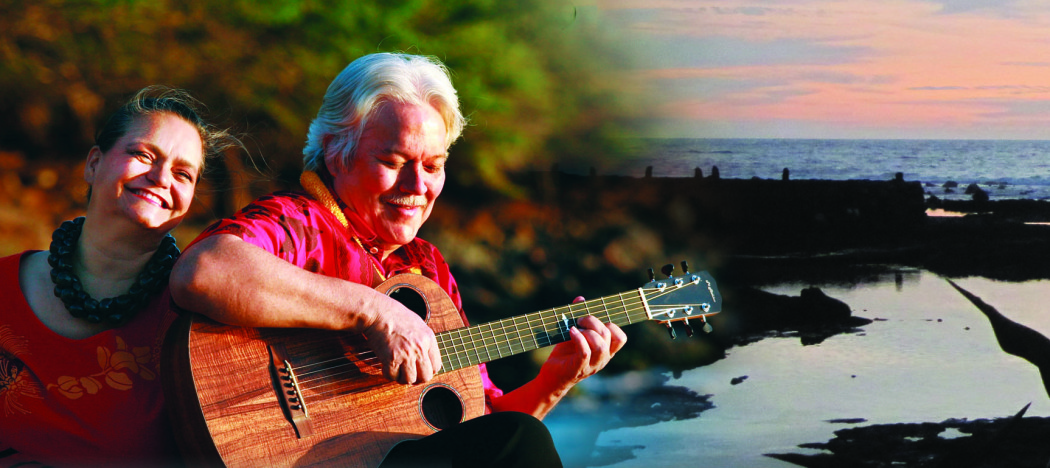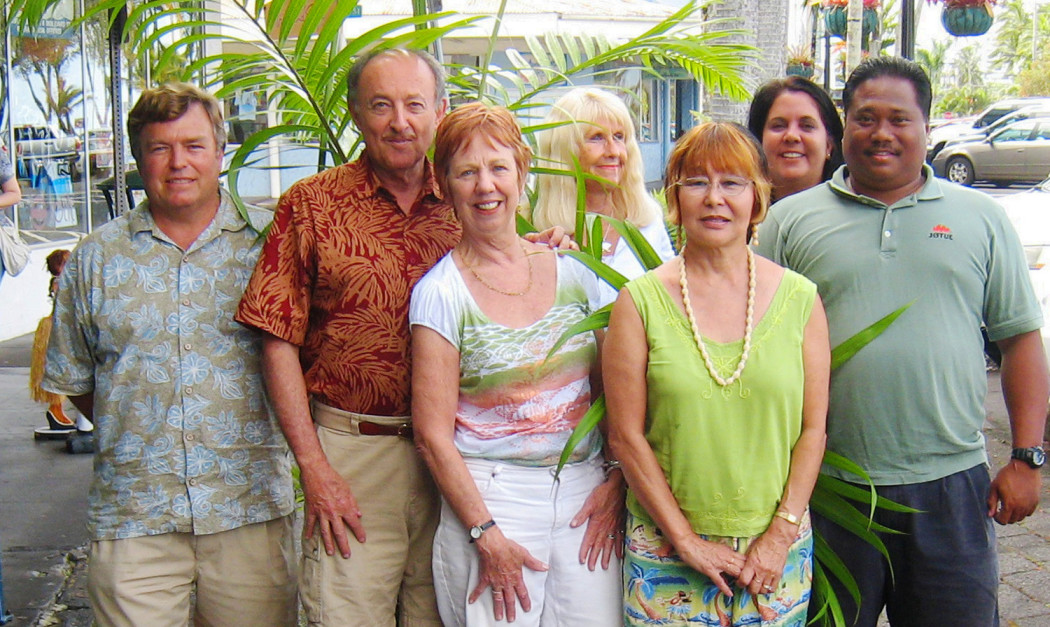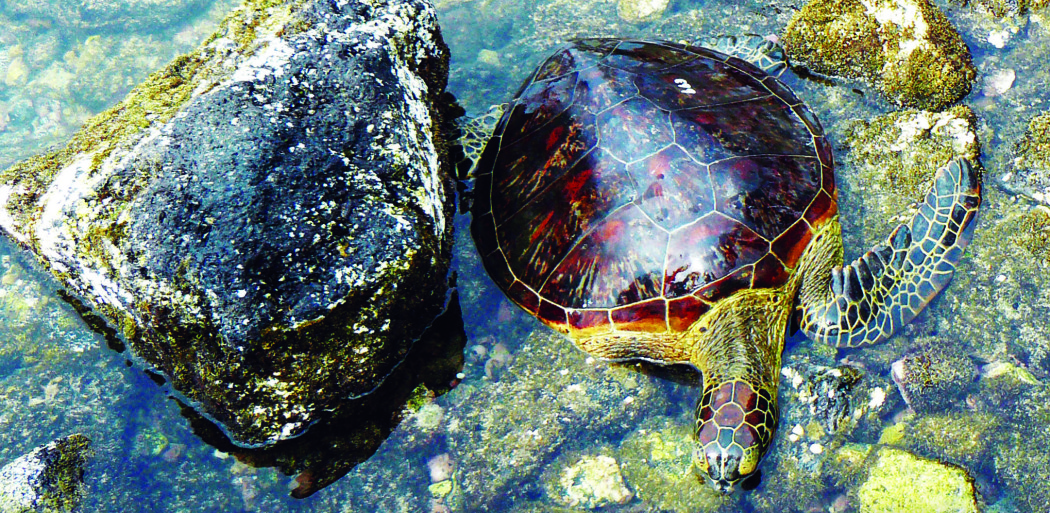
Aloha Music Camp: Awakening Hawaiian Spirit—Keola Beamer and Mohala Hou ‘Ohana
 By Marya Mann
By Marya Mann
Slack key artist Keola Beamer, world traveler, performer, composer and master musician—a Hawaiian who has earned a place on Billboard’s Top World Music Albums chart – also has a sense of place.
Today it’s Keauhou, a historically significant locale that has become the new site of the Beamer ‘ohana’s bi-annual Aloha Music Camp, an authentic Hawaiian immersion experience led by expert teachers. In a not-so-accidental coincidence, the place has special meaning to the family’s heritage [see page 72, “Ka Puana”]. It is near the site of a major battle involving a direct descendent, Chiefess Manono, wife of Kekuaokalani, who challenged King Kamehameha II for Hawaiian spiritual beliefs.
It’s late June at this year’s summer camp, and a scent of green rose floats in the moist air at the Keauhou Beach Resort. A gathering of students and first-rate artists: Hawaiian slack key guitar, ‘ukulele and hula; voice, lei-making and oli; ancient arts of ipu- and ‘ukulele- making. And adding to the experience: how to charge a field with chant, build ‘ohana, savor the value of timeless, fun-loving talk story—parts of Hawaiian culture you can’t read about in Atlanta or study in the musical tablature. You have to be here, in the context, in Hawai’i, says Keola, to have the Hawaiian sense of place.
Keola, who feels at home on Hawai’I Island, where he grew up on the Beamers’ Waimea ranch, says, “Each island has its mana, or its spiritual essence.”
On the resort lanai, the lively ‘ohana is talking story, an art that Keola enjoys almost as much as strumming the strings of his custom-made, Dennis Lake slack-key guitar.
“The Chinese would say its chi, its energetic spirit; certain places have their different sort of micro energies. Whenever I’m on Kauai, for example, the energy there is dangerous because I feel that I should just. . . . surf.” A sudden burst of laughter. “And the last time I did go surfing there, after about 30 years, I got on a board and I was paddling out and this arm got tired.” He droops one of his famous hands down toward the floor. More laughing. “And I heard someone swimming up behind, a young woman, and she goes, ‘Uncle, you need help?’”
Keola’s comic look of disappointment cracks up everyone on the hotel’s Kama’aina Terrace. The gentle man with large, graceful hands, white hair and magnetic eyes credits his famed mother, the late Winona Kapuailohiamanonokalani Desha Beamer, for the many traits and skills she left to all her sons, hānai daughters and an extended network of protégés around the world.
Auntie Nona, as everyone calls her, cooked up the idea for a week-long immersion music camp 10 years ago, when her son Keola’s career was at a turning point.
“I was doing a workshop in Seattle,” he says. “I only had three hours, then I had to go do a gig somewhere else and another workshop. I would hear the music being played, but I never had any time for the context.” The room, the notes, the rhythm seemed flat. A weird disconnect between his music and the sense of place that inspired it led him back to Hawai‘i to see his mom.
“She said, ‘You know what, Keola, it’s because you don’t have the time, and because of that, you can’t explain the context. We need to ask people to come to Hawai‘i to join us,’ and that’s how Music Camp was started.”
Here at Keauhou, overlooking the iridescent waters of Kahalu’u Bay, students enjoy what Keola calls “contextual learning,” studying the living history of Hawai’i in the ancient royal compound. Amid three carefully tended heiau and secret gardens sprouting pūnāwai, or freshwater springs, the Beamer ‘ohana message falls on fertile ground.
Moanalani Beamer, Keola’s wife and Camp Kumu Hula, chants the traditional welcoming oli, the “Oli Aloha,” describing the aromas of hala and lehua. She learned from Auntie Nona that “the plants represent male and female presences in the ancient tradition. The chant says that, like the male and female, we have long awaited your coming, and now that you’re here, love has come with you.”
Keola picks up the thread of her story. “You know when Moana was talking about these fragrances, it reminds me that in Hawaiian culture we really believe in learning in the context of the environment. When Moana smells a green rose [and dances the Green Rose Hula], it fills her whole being. She knows it. She has sensed it.” This sensitivity is the context for the music and the culture, he says.
With an extended ‘ohana of devoted artists, scholars and supporters, the Beamer family believes that here at Keauhou students can feel Hawaii’s ancient family tree, both roots and branches, and carry the story forward.
Mohala Hou, meaning Hawai‘i’s “new blossoming,” is the name chosen a decade ago for the Beamers’ non-profit foundation, which offers scholarships and programs for youth-at-risk and others who want to immerse themselves in island culture at Aloha Music Camp.
“We’re really grateful, says Keola. “I mean, like the Reverend Dennis Kamakahi, [also a kumu at the camp], we all came from the guitar world, and at one time we were afraid this would die out completely. As a culture, we were holding the information so tightly so all the tunings were secret. A family passed them down from father to son. It was so hard to learn. There was no written material.”
That changed when Keola, at the age of 19, wrote the first method book on Hawaiian Slack Key Guitar, based on a 16th century tablature system for the lute. All this, to “keep aloha alive,” says Keola. “Mālama ko aloha.”
Monday: Pō‘akahi (poh ah-kah-hee)
Away from the hum of modernity, on the slopes of Hualalai volcano, turning down the din of surface noise and turning up the volume on the ancient calming breath, the breath of the long ha. The Ma-Ha-lo. Gratitude.
Luthier Dennis Lake is offering “Build Your Own Pineapple Ukulele” in the coconut grove. Then Kumu Kapono’ai Molitau is helping a dozen students meld two gourds to make custom ipu heke that will accompany the voices in his oli class.
Under the soaring white tent in the Royal Gardens, the subject today, like every day, is love and melody, love and texture, love and tempo.
Tuesday: Pō‘alua (po ah-loo-a)
Even though the lesson is hula, the class is making lei. And even though Moanalani Beamer began hula training at the age of four with Kumu Hula Johnny Hokoana and later starred in Maui’s prestigious hotel shows, her guiding influence was Auntie Nona, her beloved mother-in-law.
“Today’s project is really small,” she says, her mellow brown eyes smiling. “We know the numbers of fern tips needed for haku lei, and we pick only those.” Leading dancers in the fundamental preparation for hula, connecting with nature, the search for natural lei materials must be conscious. At a ti plant, she says, “Don’t pick it clean. Leaving behind stuff is okay. Not everything is for you. If you’re a hoarder, no.”
Returning to the hula tent, Moana shows how to lay out greens, ferns and flowers in organized lines to create the kupe’e, ankle adornments, that bond dancers with the earth.
In the intermediate hula class later, dancers’ arms and hips flow to the tunes of “Henehene Kou ‘Aka” – “You Laugh so Pleasingly.”
Bridges between ground and sky, with ‘ami and kāholo, we move on gliding feet. Slack key guitar and heavenly voices in the distance.
Wednesday: Pō‘akolu (poh ah-ko-loo)
Sounds of playful strings. In the cool, fragrant Banyan Gardens, Kaliko Beamer-Trapp is teaching intermediate ‘ūkulele. Relaxed students sit on chairs under an open-air tent with sheet music perched in front of them. Some barefoot, some Hawaiian, some not, everyone is attentive.
Kaliko is strumming, talking, answering cell phones, taking messages, singing, and saying, “I can’t believe we’re doing all this in a week. What key are we in?” Kaliko laughs.
“F,” somebody declares.
“What key do you want?” says Kaliko. “It’s up to you. Just be sure and add a C7 here. Just give it some strummy stuff.” They dive into the frolicking plink plink, plink plink of “Beautiful Kahana,” a song by Mary J. Montano from Auntie Nona’s songbook and interpreted into English by Kaliko himself.
Playing loose, free and on key a few minutes later, all the students unify.
Kaliko, a British scholar, came into Auntie Nona’s family at a time when she feared the culture would die out. The Beamer family made him hānai in 1995 in a surprise ceremony, and he now teaches in the Hawaiian Language program at UH-Hilo when he’s not producing language immersion CDs.
To put an exclamation mark upon these facts, you have to look back to the 1930s, when Nona was a student at Kamehameha School, a time when the Hawaiian educational system had outlawed the cultural language, dances and songs! Auntie, at age 16, orchestrated school protests, singing and—Pele forbid—doing standing hula during a tea for the school trustees—offenses for which she was suspended…twice.
“My mother used to be very saddened by that,” says Keola Beamer. “She had to go to Columbia in New York and take anthropology because that is the closest she could get to a teaching degree in Hawaiian culture.”
“Where there was no Hawaiian language class,” adds Moanalani. “So she had to take German!” Auwē!
Those experiences infused Auntie Nona and the Beamer extended family with an unwavering passion for restoring, rediscovering and sharing the genuine forms, tones and tonics of real “Hawaiiana,” a term the grand lady of Hawaiian culture coined herself in a 1948 speech to teachers.
Music campers from Iowa, Japan, Hilo and Hawi find the ancient platform for creativity, the shrine that blossoms under watchful eyes of appreciation, the perspective Auntie Nona emphasized more than any. Appreciating what the rest of the planet seems to have forgotten: mahalo and music, movement and mana.
In the papa ‘olelo language class on the Kalanikai Lanai, Kaliko teaches that the feeling behind the words conveys everything. Being as careful with ‘okina placement and pronunciation as in finger-plantings on the slack key guitar with Keola, the learning catches you off-guard. You’re picking up the voice, the sound and the kauna—hidden messages behind the words—because they’re fun, pleasurable, sweet.
Thursday: Pō‘aha (poh ah-ha)
In Melinda Caroll’s voice training class, the teacher intones, “All the parts, all your voices, create this beautiful texture. Relax, enjoy, make your move, and let yourself go into the sound. Whatever comes out, let’s just have fun,” says Melinda, another of Auntie’s protégés. Textured men’s voices blend with the sopranos, not yet perfect, but moving, perky yet soothing.
It does what Auntie Nona said music must do. “It’s more important what you feel,” she said. “The feeling is what translates to the doing. And without feeling, there is no doing. So you don’t transmit it to other people unless something is ignited in your heart. Whether it’s good or sad or bad, it’s got to start there first.”
KonaBob, aka Robert Stoffer, stands beside Melinda, serving up the backbeat with his fretless, lightweight wonder, the Walkingbass. The creativity of people never ceases to amaze me.
In Hawai’i, geniuses are like geckos. Under every palm tree.
Outside on the Kama’aina Terrace, we overlook King David Kalākaua’s Po’o Pond and the ancient canoe landing. More talk story. Keola muses on the “full circle of learning” fostered at Music Camp. “The music is a vehicle for the culture we come from,” says Keola. “We all come up different sides of the pyramid, Moana with her hula, me with the guitar stuff, and Kopono’ai with the oli. We’re all working towards the same place of ‘mālama ko aloha.’ Keep the aloha alive. It’s all about music and all about aloha.”
A group of school children are preparing to sing “Hawai’i Pono’i” on the verandah. “There’s a full circle of learning here,” Keola points out. “See those Explorations Academy students there. Mom and Dr. Mitchell had this outreach van at Kamehameha Schools on O‘ahu, where they would go to different places and have their workshops, then get back in the van, and go around and teach, just the two of them. That blossomed into Explorations all across the state, and so I really feel my mom’s presence when I look at these kids.”
A blessing shower of rain begins to fall on the glistening green of Keauhou. It’s only Thursday but the expectation over Saturday night’s hō‘ike is palpable. Hō’ike means “show or revelation.” As I wonder what Lono and Laka will reveal on Saturday night, the sun sets and a rainbow rises to surprise us. The whole western sky glows in streams of purple, rose and gold.
Friday: Pō‘alima (poh ah-lee-mah)
The dappled light of another day in paradise awakens, warm but clear, blue and fresh. Cool breezes flow down from Hualalai and late afternoon showers chase away any remnants of tropical lassitude during this day of preparation for Hō‘ike. Everyone lets the mana flow and the body remember what its cells have absorbed all week.
Saturday: Pō‘aono (poh ah-o-no)
How beautiful Hō‘ike is! Nobody knows what’s going to happen. Newly crafted ‘ukulele and ipu heke are displayed. Their proud creators grin. Flowers in hair, aloha shirts, ti leaf lei. Audience and performers, everyone is talking story. Drenched in pleasure, we watch as the liquid fire of strings, the cool tones of ipu and a breath of fresh aloha takes the stage. Bravaloha!
Something magnificent glows inside the students, the teachers, the expectant audience members. A light behind the eyes, the secret gleam of sonic ecstasy. When neurons switch into their naturally pono positions, is that beaming a state we could actually call a “beamer”? Expanded smell, sight, touch, taste, sound and feeling. A field beyond words.
That’s why we make music and dance! ❖
Aloha Music Camp c/o Mohala Hou Foundation: www.alohamusiccamp.com, 1.808.531.6617.
The Mohala Hou Foundation offers programs to expand Hawaiian cultural understanding and practice through “Guitars in the Classroom” and a scholarship program for kumu, kūpuna and Hawaiian youth to attend Aloha Music Camp: www.mohalahou.org.
Winter Camp is scheduled for February, 2012
Read more about www.kbeamer.com and www.konaweb.com
Contact writer Marya Mann at marya.mann@gmail.com.


